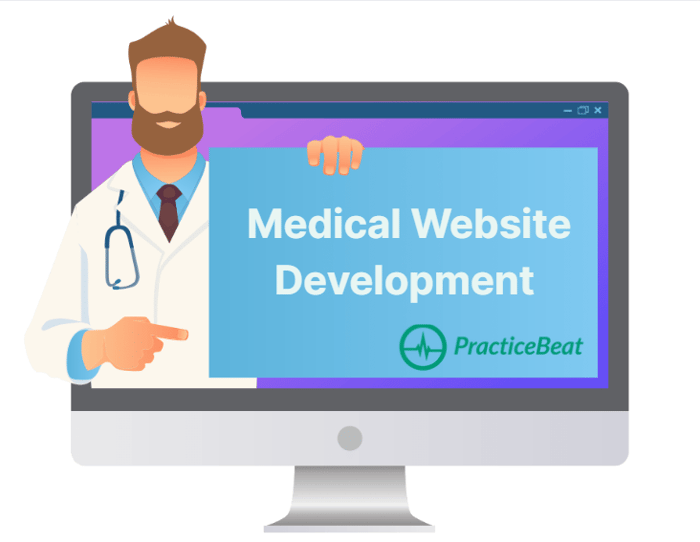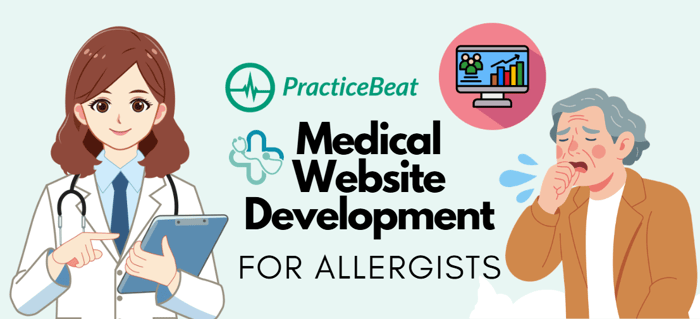Winning Healthcare Social Media Marketing Strategy | PracticeBeat
Learn how to build a high-converting healthcare social media strategy for doctors. PracticeBeat’s 2025 guide helps your practice grow with real...
Transform your allergy practice with PracticeBeat's high-performance medical website development, boosting patient engagement and handling seasonal surges.
Table of Contents

The rhythm of an allergy practice is cyclical, defined by predictable, yet often overwhelming, “hay fever” seasons. Spring, summer, and fall bring spikes in patients battling tree, grass, and ragweed pollen, while year-round allergens like pet dander and dust mites keep clinics busy even in the off-season.
And today’s allergy patients aren’t waiting around; their symptoms, seasons, and search habits change fast.
Modern patients expect instant answers, mobile-friendly pages, online scheduling, and trustworthy medical content. They compare providers online, skim AI Overviews, rely on zero-click results, and make decisions based entirely on digital experience long before stepping into your clinic.
This is exactly where medical website development, explicitly built for allergists, becomes mission-critical.
A generic medical website won’t cut it anymore. Your website must operate as a 24/7 digital front door: managing seasonal surges, supporting educational content, streamlining care access, and delivering a patient-first, privacy-first experience.
With the right web design for medical practices, medical practice website design, and healthcare website design for allergy practices, your site becomes a powerful engine that attracts, educates, converts, and retains patients.
Whether someone is searching “allergist near me,” reading symptom guides, or comparing providers in AI summaries, your website shapes their decision instantly. Slow load times, outdated information, and poor UX push potential patients straight to another specialist. But with modern medical website development for allergists, your site transforms into a high-performing digital asset that ranks, converts, and builds trust.
In this blog, PracticeBeat experts will deep dive into how advanced medical website development, modern website design for doctors, and healthcare website design for allergy practices can transform your online presence.
You’ll learn how to blend SEO, UX, HIPAA compliance, and seasonal behavior insights to help your allergy practice rank higher, attract more patients, and thrive during peak surges.
Let’s rebuild your website into something patients and search engines trust.

As winter approaches in the U.S., allergy practices face a very different kind of surge, one driven not by pollen, but by indoor allergens. Dust mites, mold spores, pet dander, and dry indoor air trigger a wave of symptoms that sends patients searching for help long before spring arrives. This seasonal shift exposes the limits of outdated websites that can’t keep up with changing patient behavior or rising digital expectations.
Without modern medical website development, allergy clinics run into familiar, recurring challenges:
These challenges aren’t just seasonal—they’re structural. And they reveal why a traditional website isn’t enough for today’s allergy practice. You need a patient-first, privacy-first digital platform that can handle fluctuating demand, support clinical continuity, and guide patients with accurate, trustworthy information year-round.
Unlock your Free Growth Assessment + Competitive Diagnosis to stay their first choice.
Understand your strengths, your competitors' weaknesses, and what’s costing you patients.

Modern allergy practices don’t just need a general medical website; they need an innovative, scalable, patient-first digital system that can withstand the unpredictable spikes of winter allergens and the overwhelming rush of spring and fall pollen seasons. This is where advanced medical website development becomes transformative. By evolving your website from a static brochure into an interactive healthcare hub, you can streamline operations, reduce staff burnout, improve patient outcomes, and keep your schedule full, even during the toughest surges.
Below are the essential features every modern allergy practice website must have to thrive year-round.
Patients today won’t wait on hold, especially when symptoms flare. They expect self-service options that mirror the ease of booking travel or shopping online.
A modern scheduling system offers:
This structured approach, built through strong website design for doctors, guides patients to the correct visit type on the first try, reduces rework for staff, and streamlines clinical operations.
For allergy patients, environmental data isn’t extra; it’s essential. Your website should help patients understand triggers and manage symptoms proactively.
Key features include:
This transforms your website into a personalized allergy management tool, one that empowers patients and supports better clinical decision-making.
A strong patient portal is the backbone of any modern allergy practice, especially during seasonal spikes when patient volume surges and symptom questions increase.
Your portal should offer:
A well-designed portal dramatically reduces call volume, streamlines your clinic workflow, and supports stronger long-term treatment adherence.
When patients start Googling symptoms, your practice should be their first and most credible source of information. A strong content hub positions you as the go-to expert year-round.
Build authority and SEO strength by offering:
High-quality educational content improves trust, reduces misinformation, and strengthens your SEO by helping you rank for high-intent, seasonal, and local keywords.
Schedule a free consultation from PracticeBeat’s healthcare marketing experts and get personalized recommendations to transform your medical website 5for faster growth and stronger patient engagement.
When allergy symptoms spike, patients want immediate relief, not long waits or unnecessary clinic trips. Telemedicine gives your practice the agility to meet urgent needs without overwhelming your schedule.
A modern allergy website should support:
Telemedicine reduces clinic congestion during peak seasons, expands access for busy patients, and strengthens continuity of care throughout the allergy cycle.
With over 70% of healthcare searches now happening on mobile, your website must feel effortless, especially when patients are experiencing sudden symptom flare-ups.
Your site must deliver:
A slow or clunky site equals lost patients, especially during urgent seasonal spikes when every minute counts.
AI assistants have become a must-have feature in modern medical website development, especially for allergy practices that experience sudden seasonal surges. They ease staff workload while giving patients the instant answers they expect.
AI tools can support your practice with:
By offering real-time support, AI ensures no lead slips through the cracks, even during high-volume allergy seasons.
For most patients, the search for an allergist starts with Google’s local results. If your practice doesn’t appear in the top three map listings, you’re losing high-intent patients to competitors.
A strong medical website development strategy for allergy clinics must include:
With strong local SEO and a credible online reputation, your practice stays visible and competitive exactly when patients need you most, during seasonal spikes and year-round allergy flare-ups.
Once you’ve built a strong foundation, advanced features can further elevate your digital experience.
Book a free demo with PracticeBeat. We’ll show you exactly where your website stands, what’s blocking your growth, and how to unlock more patient bookings, season after season.

A fully responsive, ADA-compliant design ensures patients can book from any device without friction. PracticeBeat optimizes speed, layouts, and engagement elements for allergy patients who typically search during seasonal flare-ups.
PracticeBeat builds your site with advanced SEO architecture, including schema, internal linking, and structured content. This helps your practice rank for keywords like allergy testing near me, immunotherapy, and seasonal allergies treatment.
PracticeBeat creates structured, patient-friendly content for standard allergy services and tests. Pages educate patients and reduce calls by answering questions about symptoms, causes, diagnostic steps, and treatment choices.
Patients can book appointments instantly without calling the office. PracticeBeat integrates seamlessly with your EHR or scheduling platform to reduce workload and eliminate bottlenecks.
AI tools reduce staff workload, improve triage, and help patients get quick answers. This ensures no lead slips through during high-volume allergy seasons.
PracticeBeat ensures your allergy practice dominates local search results and builds a strong reputation across Google and top directories.
You get complete visibility into what’s working, from traffic and rankings to appointment conversions.
From SEO to telemedicine to intelligent automation, PracticeBeat does it all.
Book a free demo and upgrade your digital presence.

For allergy practices, seasonal spikes and patient expectations demand more than a generic website. PracticeBeat Medical Website Development is designed to be your practice’s ultimate digital engine, streamlining online scheduling, boosting patient engagement, supporting HIPAA-compliant portals, and delivering mobile-first, lightning-fast experiences. Every feature is tailored to help allergists attract, educate, and convert patients, even during peak allergy seasons.
With PracticeBeat, your website becomes more than a virtual presence; it’s a 24/7 growth driver that elevates patient trust, reduces administrative burdens, and ensures your practice stays competitive year-round.
See exactly how your allergy practice stacks up against competitors and discover actionable ways to boost patient bookings and retention. Compare features, performance, and ROI with other platforms, and let PracticeBeat Medical Website Development show you the path to a modern, patient-first digital experience.
👉 Schedule your free demo and assessment today → compare.practicebeat.com


A: Medical website development for allergy practices involves creating a patient-first, privacy-focused website that handles seasonal surges, streamlines online appointments, and provides educational content. It combines healthcare website design for allergists with secure patient portals, mobile optimization, and local SEO for maximum patient engagement.
A: A patient-first website ensures allergy patients can access information, book appointments, and track symptoms quickly. It improves patient experience, boosts treatment adherence, and positions your practice as a trusted authority. Modern web design for medical practices also supports telemedicine and real-time integration of environmental data.
A: By integrating features like online scheduling, symptom trackers, pollen forecasts, and AI-powered triage, medical website development helps allergists manage spikes in patient demand. These tools reduce staff workload, improve patient outcomes, and ensure your practice remains visible and competitive during peak allergy seasons.
A: HIPAA compliance in medical website development ensures secure handling of patient records, messages, and portal data. For allergy practices, this builds trust, protects sensitive health information, and enables secure online booking, billing, and telemedicine, thereby enhancing patient confidence and regulatory compliance.
A: Local SEO boosts visibility in searches like “allergist near me” and drives high-intent traffic. Optimized Google Business Profiles, location-specific pages, and automated review management help allergy practices appear in local search, attract new patients, and maintain a competitive edge in their region.
A: Yes, telemedicine integration allows patients to schedule virtual consultations, follow up on treatment, and monitor chronic allergies remotely. Medical website development for allergists includes secure video visits, remote monitoring tools, and symptom reporting, ensuring continuous, accessible care during seasonal spikes.
Learn how to build a high-converting healthcare social media strategy for doctors. PracticeBeat’s 2025 guide helps your practice grow with real...
Elevate your orthopedic practice with PracticeBeat’s medical website development, designed to boost patient access, online visibility, and patient...
Learn actionable digital marketing tips for private practices. Boost patient growth with SEO, online reviews, and reputation management with...